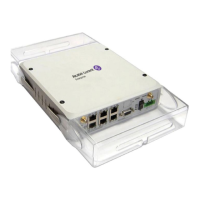Log Command Reference
266 7705 SAR OS System Management Guide
Log File Commands
file-id
Syntax [no] file-id log-file-id
Context config>log
Description This command creates the context to configure a file ID template to be used as a destination for an
event log or billing file.
This command defines the file location and characteristics that are to be used as the destination for a
log event message stream or accounting and billing information. The file defined in this context is
subsequently specified in the to command under log-id or accounting-policy to direct specific logging
or billing source streams to the file destination.
A file ID can only be assigned to either one log-id or one accounting-policy. It cannot be reused for
multiple instances. A file ID and associated file definition must exist for each log and billing file that
must be stored in the file system.
A file is created when the file ID defined by this command is selected as the destination type for a
specific log or accounting record. Log files are collected in a “log” directory. Accounting files are
collected in an “act” directory.
The file names for a log are created by the system as summarized in Table 32.
where:
• ll is the log-id
• aa is the accounting policy-id
• ff is the file-id
• the timestamp is the actual timestamp when the file is created. The format for the timestamp
is yyyymmdd-hhmmss, where:
→ yyyy is the year (for example, 2007)
→ mm is the month number (for example, 12 for December)
→ dd is the day of the month (for example, 03 for the 3rd of the month)
→ hh is the hour of the day in 24-hour format (for example, 04 for 4 a.m.)
Table 32: Log File Names
File Type File Name
Log File logllff-timestamp
Accounting File actaaff-timestamp

